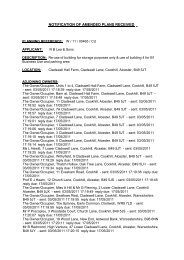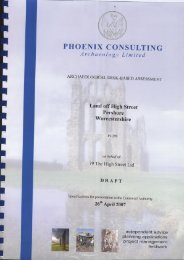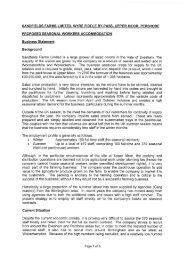Historic Environment Record Search - Wychavon District Council
Historic Environment Record Search - Wychavon District Council
Historic Environment Record Search - Wychavon District Council
You also want an ePaper? Increase the reach of your titles
YUMPU automatically turns print PDFs into web optimized ePapers that Google loves.
An <strong>Historic</strong> <strong>Environment</strong> <strong>Record</strong> <strong>Search</strong> for Land at Midland<br />
Electric Depot, Evesham<br />
Introduction<br />
The <strong>Historic</strong> <strong>Environment</strong> <strong>Record</strong> for Worcestershire is held in a GIS (Geographical Information<br />
System). This is a computer system designed to allow users to collect, manage and analyse large<br />
volumes of spatially referenced information and associated attribute data. When you request<br />
information from us on a particular area, we carry out a spatial search on a grid reference (or a<br />
specific area) supplied by you, which will bring up all the records within that area. Unless<br />
otherwise requested, the search radius will be restricted to everything within 500m of the centre<br />
point of the proposed investigation (or a 250m buffer along pipelines).<br />
If you are conducting research it must be remembered that the results of an HER search are<br />
designed to be a starting point, not a complete record. The sources mentioned in the full reports<br />
should be consulted in order to fully understand the nature of the archaeology in your search<br />
area. We strongly recommend that you come to visit the HER once you have received your search<br />
results to consult all the sources mentioned along with other more general information that we<br />
hold. The majority of the grey literature reports can now be accessed online at<br />
www.worcestershire.gov.uk/archaeology/library, other sources may need to be consulted at the<br />
HER offices.<br />
If your site is within, or close to, one of the ‘Central Marches <strong>Historic</strong> Towns’, you should consult<br />
the CMHTS report for that town. These can be found at<br />
www.worcestershire.gov.uk/archaeology/library and relate to the following towns: Alvechurch,<br />
Bewdley & Wribbenhall, Broadway, Bromsgrove, Clifton-Upon-Teme, Droitwich, Evesham &<br />
Bengeworth, Kidderminster, Pershore, Redditch, Stourport-on-Severn, Tenbury Wells and Upton-<br />
Upon-Severn.<br />
If your search area includes a <strong>Historic</strong> Farmstead or Outfarm, as identified by English Heritage's<br />
'<strong>Historic</strong> Farmsteads Project', you should consult the current project publications, including the<br />
County summary, online at http://www.englishheritage.org.uk/professional/research/landscapes-and-areas/characterisation/West-Midlands-<br />
Farmsteads-Landscapes-Project.<br />
If the search has been requested prior to development, you may need to consult the <strong>Historic</strong><br />
<strong>Environment</strong> Planning Officer (HEPO) to see how your proposal would affect the archaeology.<br />
When you request a search as part of the planning process, a copy is also sent to the HEPO (in<br />
confidence) so that he/she can determine the level and type of archaeological mitigation<br />
required, if any. If any aspect of the development changes after this point, particularly alterations<br />
to groundworks on pipeline schemes, then the HEPO MUST be informed.<br />
The HER search results will remain valid for 3 months only from the date of production, because<br />
the HER is constantly being updated as new sites of archaeological importance are identified. It<br />
should also be noted that searches are tailored to suit the needs of the client and if these needs<br />
change significantly, you may need to contact us again. Another important point to note is that an<br />
absence of archaeological sites in a particular area should not necessarily be interpreted as an<br />
absence of archaeology. It may be that surviving archaeology has not been identified in the HER<br />
for a number of reasons. If it is thought likely that archaeology could exist in such an area, then<br />
the HER team or the HEPO will inform you of this.<br />
Guidelines for Access<br />
The HER was set up as a planning tool 30 years ago and contained the minimum level of data.<br />
Since then the records have been added to and enhanced over the years as more information has<br />
come to light. The records, therefore, vary greatly in their detail and accuracy. We are constantly<br />
2






